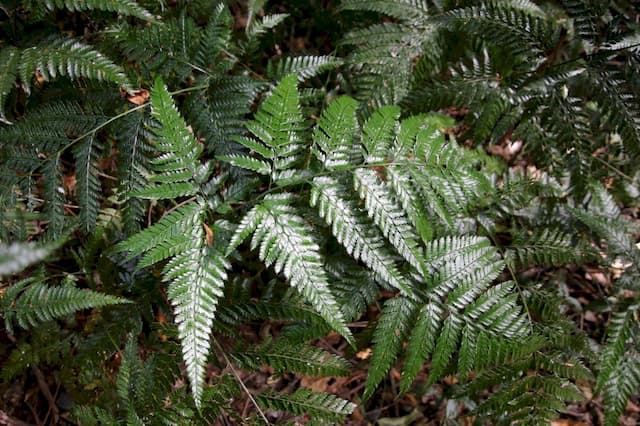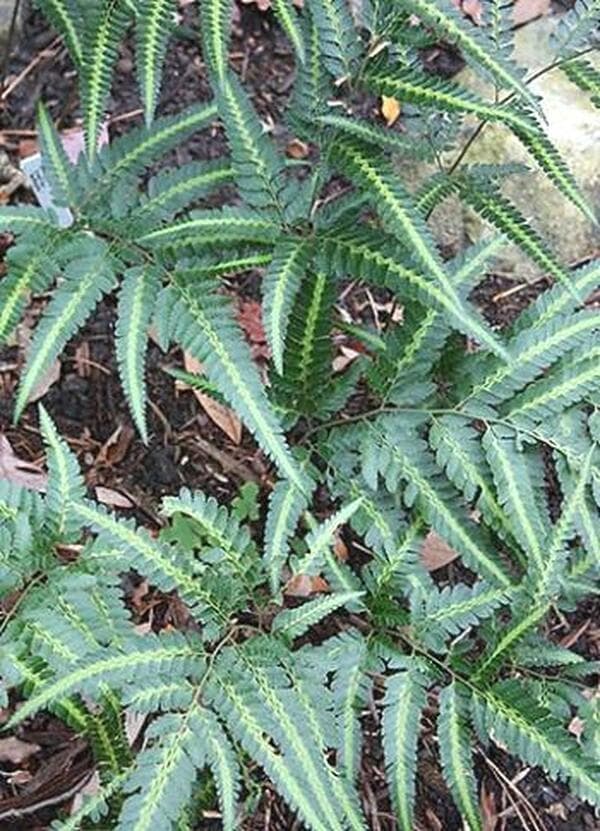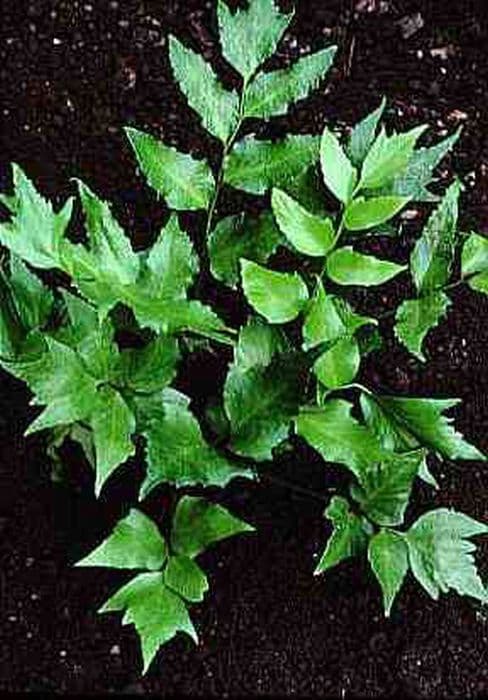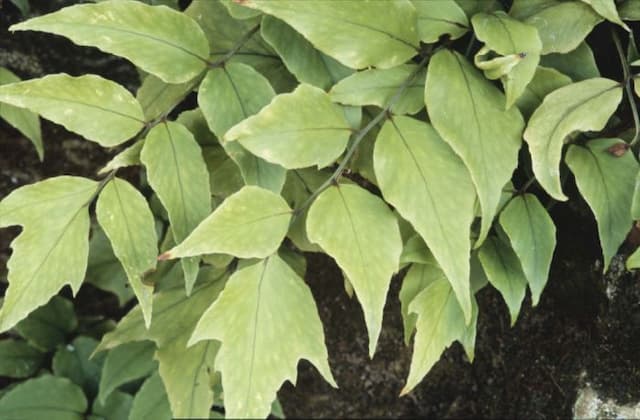Golden Male Fern Dryopteris affinis 'Cristata Angustata'

ABOUT
The plant known as the Golden Male Fern is an ornamental fern characterized by its attractive fronds, which are cut into narrow segments. The fronds have a unique textured appearance because each leaflet, or pinnae, is further subdivided and exhibits crinkly, wavy, or crested tips, giving them an intricate and lace-like quality. This rich green foliage develops its distinctive color as it matures, sometimes with a hint of golden-green hue that may be especially noticeable in the sun. The fern has a bushy and dense habit, providing a lush and voluminous look. The foliage is arranged in a rosette, creating a circular configuration of leaves that emerge from a central point. It's noteworthy for its hardiness and perennial nature, returning year after year to grace garden spaces with its elegant and arching foliage. It's regarded as an appealing choice for shaded or woodland gardens, where its unique texture and color can be used to create visual interest under a canopy of trees or in other low-light garden areas.
About this plant
 Names
NamesFamily
Dryopteridaceae
Synonyms
Golden Shield Fern, Narrow Crested Male Fern
Common names
Dryopteris affinis 'Cristata Angustata'
 Toxicity
ToxicityTo humans
The Golden-scaled male fern (Dryopteris affinis 'Cristata Angustata') is not considered toxic to humans. There are no well-documented cases or reports that indicate that this plant is poisonous, and ingesting it generally does not lead to any serious consequences for human health. However, as with any plant that is not typically used for food, consumption is not advised and could possibly cause mild stomach upset or an allergic reaction in sensitive individuals. It is always best practice to avoid ingesting parts of ornamental plants without thorough knowledge of their edibility or toxicity.
To pets
The Golden-scaled male fern (Dryopteris affinis 'Cristata Angustata') is also not considered toxic to pets. It is not typically associated with poisoning, and consumption of this plant by pets does not usually lead to any severe health problems. Nevertheless, as with humans, it is not recommended for pets to eat ornamental plants since they can potentially cause gastrointestinal upset or an allergic reaction in some animals. If a pet consumes a large quantity of any non-food plant, it is prudent to monitor them for any signs of distress and consult a veterinarian if any adverse symptoms appear.
 Characteristics
CharacteristicsLife cycle
Perennials
Foliage type
Evergreen
Color of leaves
Green
Height
2 feet (60 cm)
Spread
2 feet (60 cm)
Plant type
Fern
Hardiness zones
5
Native area
Western Europe
Benefits
 General Benefits
General Benefits- Ornamental Value: Adds visual interest to gardens with its unique crested fronds.
- Shade Tolerance: Thrives in shady spots where other plants may struggle.
- Low Maintenance: Requires minimal care once established in appropriate conditions.
- Drought Resistance: Can withstand periods of dryness once fully grown.
- Soil Improvement: Adds organic matter to soil as fronds decompose, enhancing soil quality.
- Habitat Support: Provides shelter and breeding grounds for various insects and small wildlife.
- Combats Erosion: Root system helps to stabilize soil and prevent erosion.
- Seasonal Interest: Offers year-round greenery, as it is an evergreen in mild climates.
- Companion Planting: Serves as an excellent backdrop for flowering plants and adds texture to mixed borders.
 Medical Properties
Medical PropertiesThis plant is not used for medical purposes.
 Air-purifying Qualities
Air-purifying QualitiesThis plant is not specifically known for air purifying qualities.
 Other Uses
Other Uses- The Golden Male Fern is sometimes used in terrariums or vivariums, providing a natural, forest-like environment for small reptiles or amphibians due to its tolerance of humidity and shade.
- It can be used in floral arrangements to add greenery and texture, particularly in arrangements that aim for a lush, woodland aesthetic.
- Golden Male Ferns can be planted alongside streams or water features in gardens to enhance the natural, riparian environment because they are tolerant to moist soils.
- In larger gardens, they can serve as a natural backdrop for smaller flowering plants, as their height and structure can help mitigate wind and provide partial shade.
- They can be used in outdoor theater productions or film sets that require a visually dense, forested backdrop due to their lush appearance.
- In educational settings, these ferns can be used as a hands-on teaching tool for botany or ecology courses, highlighting the biology and life cycle of ferns.
- The ferns can act as a natural mulch once their leaves decompose, providing nutrients to the soil and helping with water retention.
- Landscape designers might use the fern to create green roofs or living walls, where their ability to thrive in less-than-ideal light conditions is a significant advantage.
- Golden Male Ferns can be cultivated for use in fantasy-themed gardens or mazes due to their intricate frond patterns and height.
- They can be strategically placed to deter soil erosion on sloped areas of a garden or park, as their root system helps stabilize the soil.
Interesting Facts
 Feng Shui
Feng ShuiThe Golden Male Fern is not used in Feng Shui practice.
 Zodiac Sign Compitability
Zodiac Sign CompitabilityThe Golden Male Fern is not used in astrology practice.
 Plant Symbolism
Plant Symbolism- Resilience: As a type of fern, Dryopteris affinis 'Cristata Angustata', commonly known as the Golden Male Fern, can thrive in varied conditions, symbolizing the ability to endure and adapt to life's challenges.
- Protection: Ferns are often associated with shelter and the fern-like structure of the Golden Male Fern can symbolize a haven or protective shield from hardships.
- Eternal Youth: The Golden Male Fern's lush green foliage that rejuvenates each year can represent longevity and the renewal of youth.
- Solitude: Often found in shaded, secluded areas, the Golden Male Fern can symbolize a preference for privacy or introspection.
- Secret Bond: Victorians believed ferns symbolized secret bonds of love, and as a cultivar of a fern species, the Golden Male Fern can represent hidden emotions or connections.
 Water
WaterThe King Fern requires consistent moisture, so it should be watered deeply once a week, with adjustments made for rainfall and temperature conditions. Use about 1 gallon of water per week for outdoor ferns, ensuring the soil is moist but not waterlogged. Increase watering frequency during hot, dry periods to maintain consistent soil moisture and reduce during the cooler, wetter months. Ensure proper drainage to prevent root rot, as this fern does not tolerate standing water.
 Light
LightThe King Fern thrives in partial to full shade, making it an ideal plant for shaded garden spots or indoors near a north-facing window. It should be protected from direct sunlight, especially during the hottest parts of the day, to prevent leaf burn and keep the foliage vibrant.
 Temperature
TemperatureThe King Fern performs best in temperatures between 60°F to 75°F and can survive in temperatures as low as 55°F and as high as 80°F. Sudden temperature drops or prolonged exposure to temperatures outside of this range can be harmful to the plant, so keep it away from drafts and extreme heat sources.
 Pruning
PruningPruning the King Fern involves removing any dead or damaged fronds at the base to encourage healthy growth and maintain a tidy appearance. Pruning is best done in early spring before new growth begins. Prune sparingly, as this fern does not require heavy trimming; focus only on fronds that are clearly dead or unsightly.
 Cleaning
CleaningAs needed
 Soil
SoilThe Golden scaled male fern thrives in a soil mix consisting of equal parts loam, peat, and sand to ensure good drainage and aeration. The preferred pH range for this soil mix is slightly acidic to neutral, around 6.0 to 7.0.
 Repotting
RepottingThe Golden scaled male fern should be repotted every 2-3 years to refresh the soil and provide room for growth. Care should be taken not to disturb the root ball excessively during repotting.
 Humidity & Misting
Humidity & MistingThe Golden scaled male fern prefers high humidity levels, around 60% or higher. It should be placed in a humid environment or have humidity increased around it with a humidifier or pebble tray.
 Suitable locations
Suitable locationsIndoor
Keep in indirect light; ensure high humidity and well-draining soil.
Outdoor
Plant in shaded area, use rich, moist soil; protect from strong winds.
Hardiness zone
5-8 USDA
 Life cycle
Life cycleThe Dryopteris affinis 'Cristata Angustata', commonly known as the Golden Male Fern, begins its lifecycle with the germination of spores typically in moist and shaded habitats. These spores develop into a small, heart-shaped gametophyte, which is the sexual stage, hosting both male and female reproductive organs. Upon fertilization, it transitions into the sporophyte stage, growing into the familiar fern with its signature arching fronds, characterized by narrow and crested leaflets. As the fern matures, sori develop on the underside of the fronds, which are clusters of sporangia where spores are produced. The spores are eventually dispersed by wind, allowing the life cycle to begin anew. This hardy perennial can live for several years, with individual fronds typically lasting about 18-24 months.
 Propogation
PropogationPropogation time
Spring-Early Summer
The Dryopteris affinis 'Cristata Angustata', or the Golden Male Fern, is best propagated by division. This is usually done in the spring right before the new fronds, or leaves, start to unfurl. To propagate by division, carefully remove the fern from the ground, ensuring minimal disturbance to the roots. Using a sharp knife or spade, divide the clump into smaller pieces, making sure each piece has at least one growing point and a portion of the root system attached. These divisions can then be replanted in a shaded area with moist, well-draining soil. Water the newly planted divisions well to help establish them. It is important to keep the soil consistently moist, but not waterlogged, as the new plants acclimate and grow.









